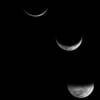When blessing the new month in the synagogue on the Shabbat before Rosh Chodesh (see: Shabbat Mevarchim), it is customary to announce the time that the molad (birth of the new moon) occurs in Jerusalem, so that it can be kept in mind while saying the blessing.
Traditionally, the time is announced in hours, minutes and chalakim — e.g., "The molad will occur Sunday evening, eight minutes and seven chalakim after seven o'clock." A chelek is one 1080th part of an hour, or 3.33 seconds. In this table, we have noted the time of the molad in hours and minutes (e.g., 7:08 PM), and we've also noted the number of chalakim, for use in the traditional announcement.
All times listed here are Jerusalem times, and are so announced in the synagogue regardless of location.
For more about the molad, see What is the molad? at the bottom of this page.
Click here to convert Secular to Jewish dates
Molad Times for 5785 (2024-2025)
|
Molad for Month of |
Day of Week |
Date |
Time |
|
Tishrei |
Thursday |
October 3, 2024 |
3:21 (13 chalakim) AM |
|
Cheshvan |
Friday |
November 1, 2024 |
4:05 (14 chalakim) PM |
|
Kislev |
Sunday |
December 1, 2024 |
4:49 (15 chalakim) AM |
|
Tevet |
Monday |
December 30, 2024 |
5:33 (16 chalakim) PM |
|
Shevat |
Wednesday |
January 29, 2025 |
6:17 (17 chalakim) AM |
|
Adar |
Thursday |
February 27, 2025 |
7:02 (0 chalakim) PM |
|
Nissan |
Shabbat |
March 29, 2025 |
7:46 (1 chelek) AM |
|
Iyar |
Sunday |
April 27, 2025 |
8:30 (2 chalakim) PM |
|
Sivan |
Tuesday |
May 27, 2025 |
9:14 (3 chalakim) AM |
|
Tamuz |
Wednesday |
June 25, 2025 |
9:58 (4 chalakim) PM |
|
Av |
Friday |
July 25, 2025 |
10:42 (5 chalakim) AM |
|
Elul |
Shabbat |
August 23, 2025 |
11:26 (6 chalakim) PM |
Click here to convert Secular to Jewish dates
Molad Times for 5786 (2025-2026)
|
Molad for Month of |
Day of Week |
Date |
Time |
|
Monday |
September 22, 2025 |
12:10 (7 chalakim) PM |
|
|
Wednesday |
October 22, 2025 |
12:54 (8 chalakim) AM |
|
|
Thursday |
November 20, 2025 |
1:38 (9 chalakim) PM |
|
|
Shbbat |
December 20, 2025 |
2:22 (10 chalakim) AM |
|
|
Sunday |
January 18, 2026 |
3:06 (11 chalakim) PM |
|
|
Tuesday |
February 17, 2026 |
3:50 (12 chalakim) AM |
|
|
Nissan |
Wednesday |
March 18, 2026 |
4:34 (13 chelek) PM |
|
Friday |
April 17, 2026 |
5:18 (14 chalakim) AM |
|
|
Shabbat |
May 16, 2026 |
6:02 (15 chalakim) PM |
|
|
Monday |
June 15, 2026 |
6:46 (16 chalakim) AM |
|
|
Av |
Tuesday |
July 14, 2026 |
7:30 (17 chalakim) PM |
|
Thursday |
August 13, 2026 |
8:15 (0 chalakim) AM |
What Is the Molad?
The Jewish calendar is lunar-based, with each month representing one lunar cycle — the time it takes for the moon to complete one orbit around the earth.
The molad is the time of the moon's "birth." There is a point in the moon's orbit in which it is positioned directly between the earth and the sun, making it invisible to anyone standing on earth's surface. The molad occurs when the moon has moved far enough from this position that a thin crescent of its illuminated surface becomes visible, marking the start of a new Jewish month.
The time it takes for the moon to complete one orbit around the earth — as calculated by sages and confirmed by astronomical observation — is 29 days, 12 hours and 793 chalakim (there are 1,080 chalakim or "parts" in an hour, hence a chelek is 3.33... seconds). This represents the average time from molad to molad. The actual moment at which the moon becomes visible will vary slightly from the average molad, depending on the relative positions of the earth, moon and sun to each other at any given month, where on earth the observer is standing, the length of twilight at given seasons of the year, and other astronomical variables.
For this reason the Jewish calendar is “tweaked” so that Rosh Chodesh — the first of the month — is as close as possible to the time in which the moon would actually be seen in Jerusalem if we were still relying on actual observation of the moon to establish the start of a new month (as was done until the 5th century C.E.). Also, because a month has to be made up of whole days, the Jewish month alternates between 29 and 30 days. This is why Rosh Chodesh will often occur a day or more after the average molad.





Join the Discussion